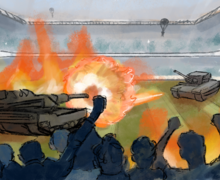Saffren: NCAA athletes should benefit from merchandise sales featuring their likeness
Former University of California, Los Angeles basketball star Ed O’Bannon might be this generation’s Curt Flood.
Flood, an all-star for the St. Louis Cardinals in the 1960s, sparked a watershed turning point in sports labor when he challenged Major League Baseball’s reserve clause in 1969. The clause allowed teams to prevent players from signing with other teams after the termination of their contracts.
Flood’s lawsuit was unsuccessful, but it led to the implementation of free agency in 1975, which became a staple across American professional sports by the 1980s.
O’Bannon is also standing up for sports subjugates. In 2009, he sued the NCAA for profiting off of the likenesses of former college athletes in EA Sports video games, according to an April 2 article on SI.com. In January, federal Judge Claudia Wilken ruled that O’Bannon could sue everyone, not just the NCAA, who profits off of the likenesses of college athletes.
O’Bannon is going straight for the jugular: television networks. He wants half of the economic revenue for athletes from television contracts. If O’Bannon succeeds and college athletes subsequently form a union, college athletics will be amateur in name only.
This would be a step too far. With television stipulations, scholarship athletes would earn a wealthy living with a free education. But financial appeasement for the biggest stars might be the only way to prevent it from happening.
The NCAA has monopolistically backed stars in revenue sports into a corner. There is no alternative route to professional fortune than the NCAA for basketball and football players capable of finding employment.
In 2006, the NBA increased its age limit from 18 to 19, mandating at least one amateur season. The NFL doesn’t allow players to turn pro until they are three years removed from high school.
With the proliferation of cable television, the financial bubble in college sports is inflating rapidly. In 2010, the NCAA reached a 14-year, $10.8 billion agreement with CBS and Turner Sports to broadcast the NCAA Men’s Basketball Tournament, according to USA Today. In November, the NCAA reached a 12-year, $7.3 billion deal with ESPN to broadcast the Bowl Championship Series starting in 2014, according to Philly.com.
College athletes are not mindless pawns. They understand that network, corporate and academic suits profit the more contracts inflate.
Therefore, before the athletes collectively try to professionalize their status, the NCAA needs to individualize a compensation system.
If an individual star brings money to the school, he should profit from merchandise sales featuring his jersey number, last name or likeness.
In the past, schools have made approximately 10 percent in royalties on every jersey sale, according to CNBC.com. A Michael Carter-Williams jersey costs $75 at the University Bookstore. The bookstore would not disclose the university’s royalty rate. But, by the 10-percent standard, SU would make $7.50 from every sale. Carter-Williams gets zero dollars and zero cents.
There is an easy fix to this unfair scenario. Burn the prenup. Let the star have half or a 5-percent royalty on each sale featuring his jersey number, last name or likeness. It would quell an insurgency with disposable, but not exorbitant, income.
In 2004, ESPN’s Darren Rovell tracked the jersey sales of two college basketball stars, Duke’s Chris Duhon and UConn’s Ben Gordon, from January to April. About 3,570 Duhon jerseys and 2,100 Gordon jerseys were sold across the country.
The royalty was 8 percent in 2004. If Duhon and Gordon got a 4-percent cut, Duhon would have earned a modest $3,034, Gordon $1,785.
O’Bannon is unlikely to win his case outright. Like Flood, he will raise awareness and possibly spark a transition. If college athletes form a union, walk-ons could become just as wealthy as the stars who move the meter. The NCAA needs to act first. Like a divorcee, it will have to meet its neglected partner somewhere in the middle.
Jarrad Saffren is a junior television, radio and film and political science major. His column appears weekly. He can be reached via email at jdsaffre@syr.edu and on Twitter at @JarradSaff.
Published on April 17, 2013 at 1:00 am





